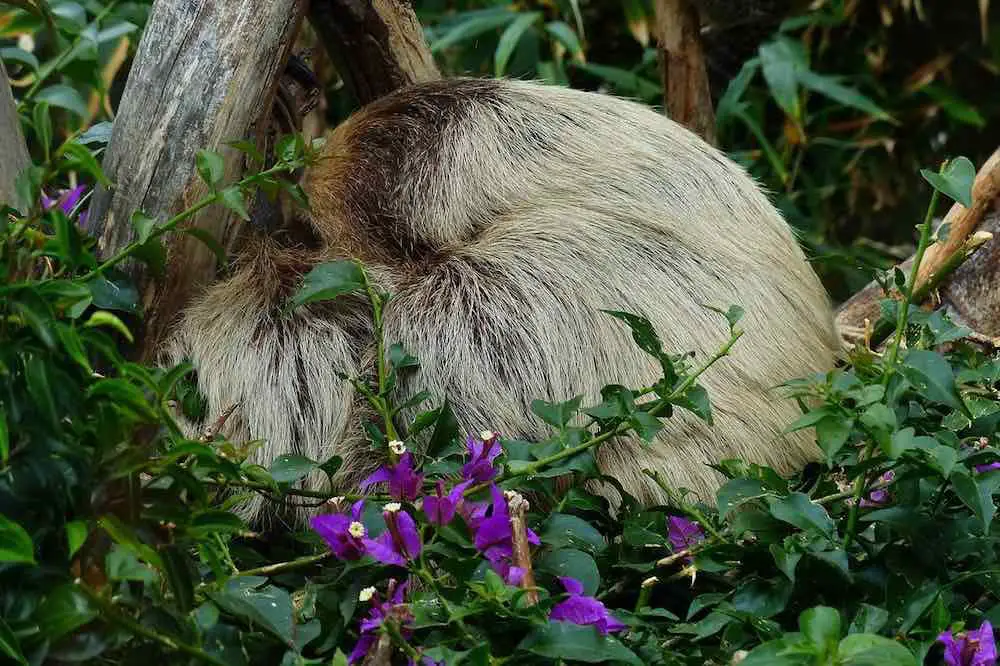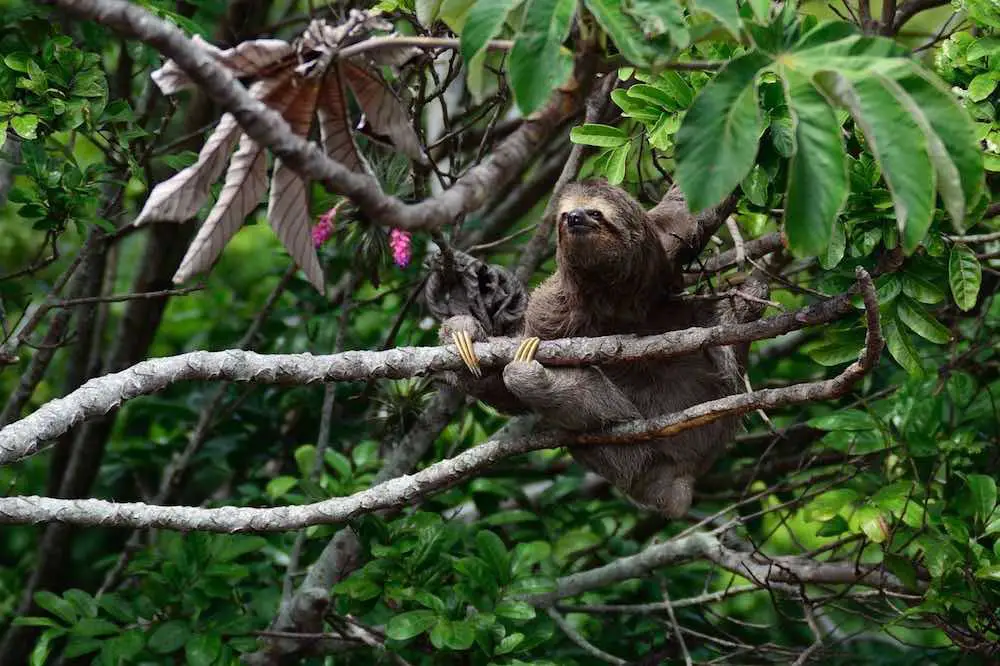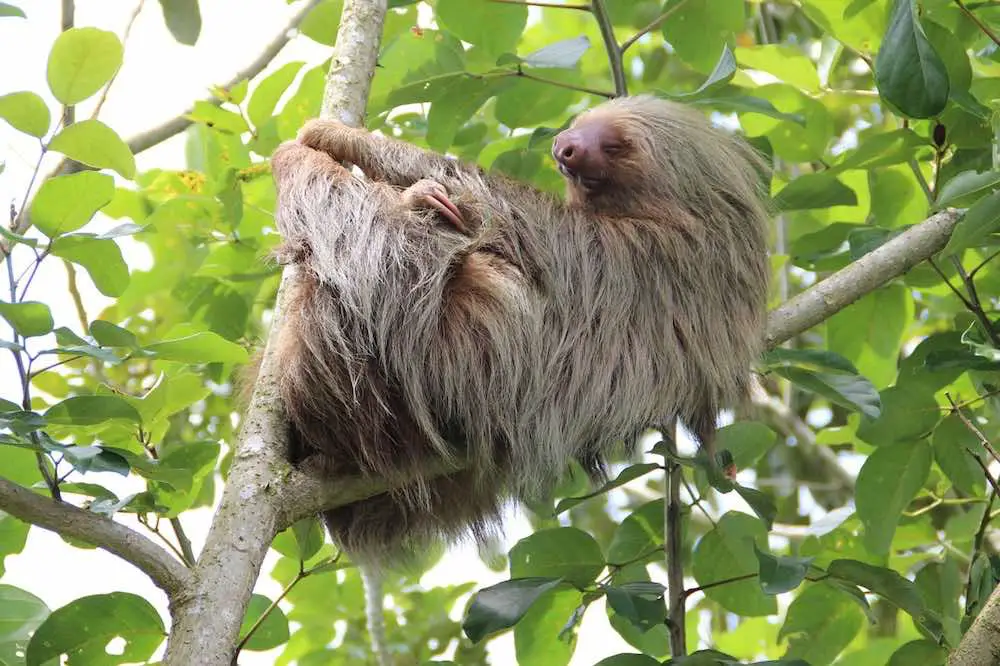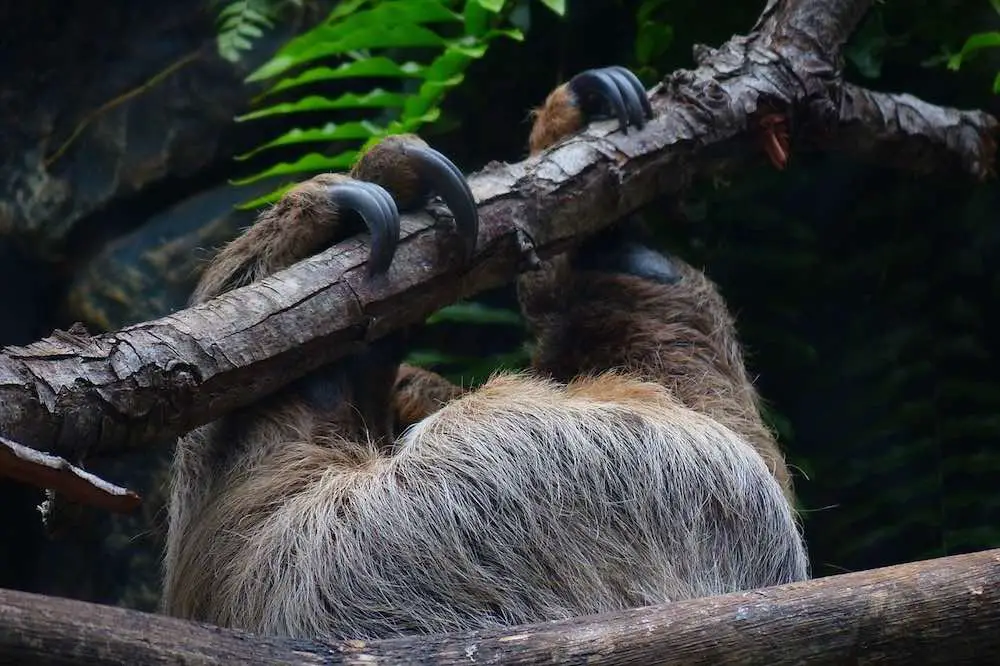
Sloths are solitary creatures, and spend almost all of their time alone. They will come across other animals, and are often preyed upon. So how do sloths protect themselves and stay safe in the rainforest?
I was interested to find out the answer to this question so did some research into this.
So how do sloths protect themselves? Sloths protect themselves by camouflaging themselves in trees, staying still and growing green algae on their fur. They live on the leaves of trees, coming down to use the toilet once a week. They can turn their heads 360 degrees to check for predators, and use their long claws to defend themselves.
So the above is the short answer to this question. If you want to find out more details about how sloths stay safe from predators in the rainforest then carry on reading below.
Contents
How Do Sloths Protect Themselves?
Did you know that there are actually 6 different species of sloths, with 12 subspecies? There are also a number of extinct species of sloths, often referred to collectively as ground sloths.
The current extant (the opposite of extinct) species of sloths are split across two families, or genera (the plural of genus). These are the two-toed and three-toed sloths.
The obvious major difference between these two types of sloths comes in the amount of toes they have. Both have three on their hind limbs, but on the front the two-toed sloth has two, and the three-toed sloth has three.
The two-toed sloth family is split into two species. These are:
- Linnaeus’s two-toed sloth (Choloepus didactylus)
- Hoffmann’s two-toed sloth (Choloepus hoffmanni)
There are 4 species in the three-toed sloth family. These are:
- Maned sloth (Bradypus torquatus)
- Pale-throated sloth (Bradypus tridactylus)
- Brown-throated sloth (Bradypus variegatus)
- Pygmy three-toed sloth (Bradypus pygmaeus)
When we are answering the question of how do sloths protect themselves, we are talking primarily about sloth predators. We are, however, also talking about how sloths have adapted to the rainforest in order to survive the conditions there.
Let’s take a look below at some of the ways in which sloths do protect themselves.
Living In Trees Provides The Best Protection For Sloths
The first and possibly most obvious way in which a sloth protects itself is in it’s choice of home within the rainforest. Unlike the ground sloths of the past, the sloths still living today are arboreal. This means that they choose to live in trees.

This is a smart choice for many reasons, more of which we will look at below. The sloth’s relationship with trees is hugely beneficial, and is linked to most or all aspects of it’s life.
Perhaps the main reason sloths gave adapted to be such tree-dwellers is because of the protection trees afford the sloth. Sloths spend almost all of their time in the trees, hanging upside down to sleep for most or all of the day, and large parts of the night too.
The trees offer the sloth a large amount of protection from predators. They live high up in the canopies of the rainforest, and these put them out of reach of many of the animals that like to prey on them.
There are a few members of the wild cat family that will hunt sloths, and staying high off the ground keeps them away from most of these. However, the margay is a skilled climber, and is able to climb trees to hunt for prey.
They will more than likely catch a sloth while it is climbing down, rather than when it is at full height in the canopies of the rainforest.
They are not entirely safe up high in the rainforest though. Eagles such as the harpy and crested eagles, that also live in the canopies, are well known predators of the sloth. The harpy eagle is strong enough to pick up and carry a sloth should they spot one.
A Sloth’s Diet Protects Them In The Rainforest
A sloths diet also helps us to answer the question of how do sloths protect themselves. As I said above, trees play an all important role in the life of the sloth. They live in them all of the time, and don’t really need to move from them.
Sloths are able to survive entirely on the leaves of trees. They can stay up there all of the time, as they do not need to move to look for food. They can supplement their diet with flowers, berries and even small insects, but there is not really a need for them to do this.
So the sloths diet helps to protect them from predators, because they do not need to move far at all to get food. A sloth’s biggest weakness when it comes to being hunted is it’s inability to move quickly.
On average a sloth can move on the ground at a speed of 4 metres per minute. This is unbelievably slow. If a predator was to happen upon a sloth, it would not be able to move quick enough to escape. So it uses it’s diet and relationship with the trees to be able to stay safe and hidden, eating the leaves in the place that it lives.
The Sloth’s Toilet Habits Can Keep Them Safe
The sloth’s toilet habits are often written about, and for a good reason. This is also closely linked to it’s life in the trees, and to the very specific diet it has.
It seems to be well written about, certainly online, that sloths do not need to go the toilet very often. They need to go roughly once in every seven to ten days. This is not very often at all! By the time they come to use the toilet, their overall bodyweight is comprised of about 30% waste.
When sloths eat the leaves from the trees that they live in, it can take between 30 and 50 days for them to digest them. The leaves on the trees in the rainforests are toxic to many animals. This is the rainforests way of making sure not all of the trees are eaten by animals.
The sloth’s stomach is split up into four chambers, and these have special bacteria in them for killing the toxins. This is all done slowly, as is everything else with the sloth. So it takes a while to digest the food.
As you can imagine for an animal that is not the quickest on the ground, going to the toilet is pretty dangerous for a sloth. Hence the number of posts written online about the dangers they face when they go to the toilet.
Sloths are able to protect themselves to some degree from these dangers by not needing to go too often. So their digestive system and in turn how often they need to go to the toilet actually helps to answer the question of how do sloths protect themselves.
A Sloth’s Fur Offers Double Protection
A sloth’s fur is a protective factor for a couple of different reasons in the rainforest. Between the different types of sloths there is some variance in the color of their fur. They are all, however, largely the color of their surroundings.
This means that they blend in with the trees that they live in. Being camouflaged like this is a hugely protective factor for them. If they can’t move quickly away from predators, then they need to be able to stay out of sight of them.

As well as the fact that they already tend to blend in well with their surroundings, there is also another interesting aspect to a sloth’s fur. Often when you see pictures of sloths, they tend to have a green color to their fur.
This is because they have green algae growing on them. This green algae is home to many creatures, such as the sloth moth, which lives entirely in the fur of sloths. This is one of the many ways that sloths help the environment.
In terms of protecting a sloth, this green algae on the sloth’s fur also enables them to camouflage themselves even more in the trees of the rainforest, as this algae is the same color as their leaves.
The sloths fur is also protective as it helps to protect a sloth against the weather in the rainforest. As you can imagine, it rains a lot there!.
Seeing as sloths hang upside down in the trees for most of this time, their fur actually grows in the opposite direction from other animals. So rather than the fur growing downwards towards a sloths feet, it grows upwards towards it’s head.
When they are hanging upside down, this allows the rainwater to run down them rather than getting stuck in their fur. This stops the sloth from being constantly soaked through, and is another way that they are able to protect themselves.
The Sloth’s Slowness Can Actually Save Them
Much has been written also about the slowness of the sloth. That they are lazy, and tend to not do much. It is true that they don’t move about much, but this is also something that helps to protect them and keep them safe.

Like I said above, a sloth’s metabolism is very slow. It takes them a long time to digest food. So they don’t move about much, and move very slowly to save what little energy they have.
There are a number of different figures that I found for how fast sloths move on the ground. It seems that in the tree they can move around 4 metres per minute, but on the ground this is closer to 1.5 metres per minute, which is what I have based my above figures on!
Sloths can actually control their metabolism. They can slow it down so much that their heart rate is a third of it’s normal rate. This helps to make sloths good swimmers, as it allows them to hold their breath for up to 40 minutes.
It’s a bit like a vicious circle really. Sloths are slow, which leaves them vulnerable to predators. So they don’t move much, and conserve energy too. This means that they don’t need a fast metabolism, as they don’t burn much energy off.
But not moving, and staying still a lot of the time actually helps to keep a sloth safe. When they are high up in the trees, they are barely visible. If they stay still, it can be virtually impossible for a predator to spot them. Less movement for a sloth actually equals more safety.
This slowness is an adaptive quality that also helps to serve another purpose. Due to the hot and humid conditions of the rainforest, and the fact that sloths are still a lot of the time, it is this that helps to promote the growth of the green algae on a sloth’s fur.
In turn this helps to keep it camouflaged. So the slowness of a sloth helps to keep it from being seen by predators in two different yet related ways.
Sleeping Saves The Sloth’s Life
Most sloths are nocturnal, meaning they only come out at night. There are, however, some that are diurnal, which means they will come out during the day. This is maybe slightly misleading though.

As sloths tend to sleep somewhere up to 20 hours a day, not much of their time will be awake time even if they are diurnal. Sounds pretty smart to me!
So how does this help us to answer the question of how do sloths protect themselves? Well quite simply, the more time they spend sleeping, the less chance there is of them being preyed upon.
Due to the fact that they are hanging high up in the canopies, are totally still, and well camouflaged, they are relatively safe from being eaten in a state of sleep.
Coming out largely at night also helps them to stay safe too. Firstly, any animals that do prey on them that are not nocturnal will be sleeping, and not out hunting. Secondly, it is harder for some animals to see them at night time than it is to see them during the day.
The Sloth’s Flexible Neck Protects Them From Predators
Now a sloth may look quite comical when it turns it’s head almost all of the way around, but this is no joke. A sloth’s ability to do this is actually one of the ways it is able to protect itself.
If a sloth is attacked, as I have said, there is no real way for it to escape. So it has to make sure it can’t be seen, hence how well camouflaged it is. Sloth’s also need to be able to spot if anything is near, and the ability to turn their head around so far helps a lot with this.
Sloth’s are able to do this due to a unique design in their skeletal structure. All of the mammals in the animal kingdom have seven cervical vertebrae, apart from the sloth and the manatee.
The two-toed sloth actually only has five of these, whereas the three-toed sloth has nine. It is the fact that the three-toed sloth has two extra vertebrae that means they can turn their heads up to 270 degrees.
The ability to do this is something that definitely helps sloths to protect themselves from predators.
A Sloth’s Claws Can Be A Lifesaver Too
The last of the answers to the question of how do sloths protect themselves lies in their claws. There are two main reasons that I have added this to the list.

Firstly, the sloths’s claws play an important part in their ability to stay safe from predators in trees. Their claws are long and curved, and are perfect for locking around the branches of trees. They can grow to between 3 and 4 inches (8 to 10cm), and are more than long enough to wrap around thick branches in the rainforest trees.
The second use a sloth has for it’s claws is in the more traditional protection sense. Now if you ever come across a sloth on your travels, don’t worry. Sloths are not particularly dangerous to humans. However, if a sloth feels threatened or under attack, it will take a swipe at a predator. With those long, curved claws, it could do some damage for sure.
Summing Up
So the answer to the question of how do sloths protect themselves is probably longer than you would think. At first glance, sloths seem like fairly simple creatures. But their relationship with the rainforest and its trees is a fairly complex one.
Sloths live in trees for a number of reasons. They offer them camouflage and protection from predators. They are also able to get all of their food from these trees. This means they very rarely have to leave them.
Their diet and metabolism means they do not have to go to the toilet very often. As this can be a dangerous affair, this is another way that sloths are able to stay safe.
The fact that sloths don’t move a lot, and come out mostly at night also helps them to stay hidden from predators.
Their fur offers them protection from the elements, and the growing of green algae on this fur also helps them to stay even more hidden from predators.
They have long claws that help them to hang in trees, and they can also be used to defend themselves if necessary. The ability to turn their heads to nearly 300 degrees also helps them to spot danger before it’s too late.
I hope you have enjoyed reading all of the information I found about how sloths protect themselves.
If you have anything to add, or have any questions, then please leave a comment below.

